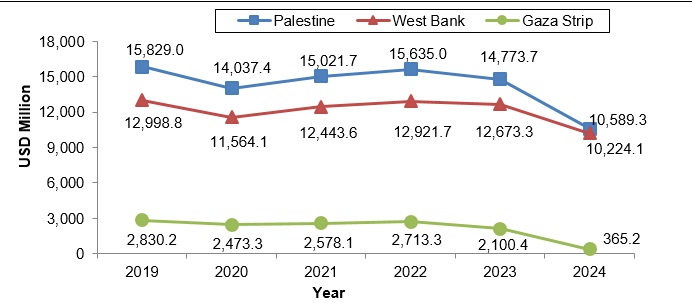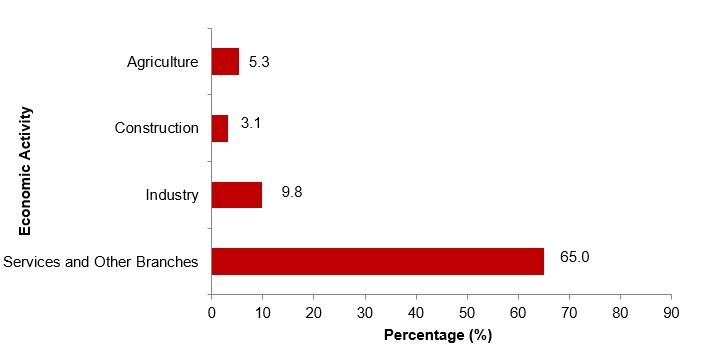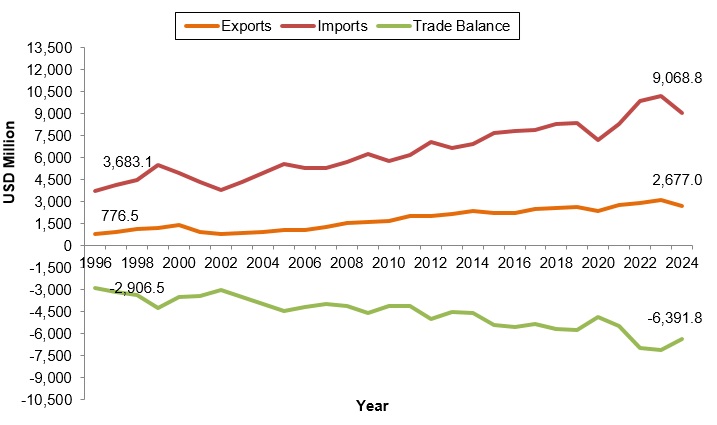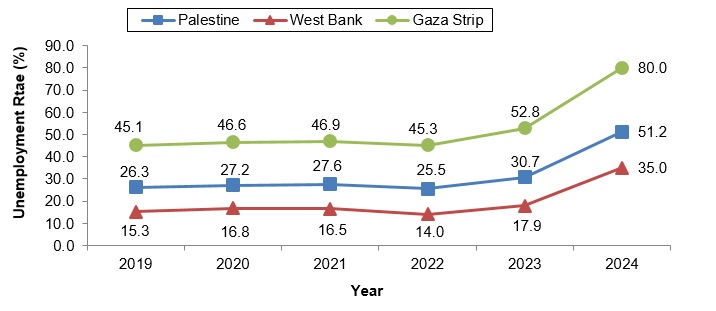H.E. Dr. Awad, President of Palestinian Central Bureau of Statistics (PCBS), Presents the following:
· The Performance of the Palestinian Economy during 2024.
· The Economic Forecasts for 2025.
H.E. Dr. Ola Awad, President of the Palestinian Central Bureau of Statistics (PCBS), presented on Tuesday, December 31, 2024, an overview of the Palestinian economy, highlighting the most significant social and economic indicators for 2024. This year witnessed the continuation of Israeli aggression against the Gaza Strip. Dr. Awad also shared the economic forecasts for 2025 as follows:
A complete collapse of the economic structure in Gaza Strip accompanied by a sharp decline in production in the West Bank and unprecedented increase in unemployment rates
Palestine is experiencing an economic, humanitarian, environmental, social, educational, and food catastrophe, which has led to a contraction in the productivity base and a structural distortion in its economy. By the end of 2024, estimates indicate an unprecedented sharp contraction in the GDP of the Gaza Strip, with a decrease exceeding 82%, along with a rise in the unemployment rate to 80%. This contraction has also affected the economy of the West Bank, where the GDP declined by more than 19%, and the unemployment rate rose to 35%. In total, these factors have contributed to a 28% decline in the Palestinian economy, along with a rise in the unemployment rate to 51%.
GDP by Region, 2019- 2024 at Constant Prices: Base Year 2015

A complete collapse of all economic activities in the Gaza Strip during 2024, along with a sharp decline in economic activities in the West Bank, with the construction activity being the most affected.
The Palestinian economy is considered a service economy, where 65% of the Palestinian economy is services, while the productive sectors that support economic growth constitute only about 20% of the total economy. This indicates that the Palestinian economy is changeable, and is significantly impacted by the challenges but it quickly recovers as it is a small economy. During 2024, most economic activities in Palestine declined compared to the previous year, as the construction activity recorded the highest decline, reaching 46% (38% in the West Bank, and 98% in Gaza Strip) to reach USD 332 million, followed by the industrial activity with a decline of 33% (30% in the West Bank, and 90% in Gaza Strip) to reach USD 1,038 million, then agriculture activity with a decline of 32% (17% in the West Bank, and 91% in Gaza Strip) to reach USD 564 million, and the services activity declined by 27% (17% in the West Bank, and 81% in Gaza Strip) to reach USD 6,453 million.
Percentage Contribution* of Economic Activities to GDP in Palestine, 2024 at Constant Prices (Base Year 2015)

(*) The summation of percentages does not equal 100 due to exceptions in adjustment items.
A decline in the trade volume from and to Palestine in 2024
The volume of trade exchange between Palestine and the outside world witnessed an 11% decline. The value of exports of goods and services from Palestine dropped by 13%, reaching USD 2,677 million. Additionally, imports fell by 11%, totaling USD 9,069 million in 2024 compared to the previous year. Palestinian imports make up more than three times the value of Palestinian exports, reflecting a consistent trade deficit in the Palestinian balance of trade. It is important to note that the largest share of trade exchange with the outside world in the Gaza Strip was recorded in 2003, at 29% of total Palestinian trade. However, this percentage has since declined to less than 4% during Israeli occupation aggression, due to the near-total disruption of supply chains into and out of the Gaza Strip. This disruption led to a health and food crisis, with basic commodities, medicines, health supplies, and food provided at minimal levels, not exceeding 5% of the necessary quantities required in the Gaza Strip.
Data indicated that the percentage of imports from Israel throughout the years have declined, where it constituted 86% of the total Palestinian imports in 1996, i.e. USD 3,184 million to reach USD 4,815 million despite the fact that it declined to 60% in 2024. In contrast, the percentage of the Palestinian exports to Israel in 1996 reached 94% where it constituted USD 730 million, but then it declined to 87% of the total Palestinian exports in 2024, with an amount of USD 2,304 million.
Trade Balance of Goods and Services in Palestine, 1996- 2024 at Constant Prices (Base Year 2015)

A Sharp Rise in Unemployment Rates in the Gaza Strip, Exceeding 80% in 2024
Palestine suffers from high levels of unemployment rates and a regional gap. During 2024, the unemployment rate in Palestine rose to 51% (35% in the West Bank and 80% in Gaza Strip). While it reached about 31% before the Israeli occupation aggression against Gaza Strip (18% in the West Bank and 53% in Gaza Strip) during 2023. The labor force participation rate in Palestine also declined during 2024 to reach 40% compared to 44% in 2023, while it reached 36% in Gaza Strip after it was 40% during 2023, while the labor force participation rate in the West Bank reached 43% compared to 47% during the same period.
Unemployment Rate by Region, 2019- 2024

Poverty and Living Standards
Prior to the Israeli occupation's aggression against the Gaza Strip, poverty rates there exceeded 63%, with the poverty line in Palestine set at approximately NIS 2,717 and the extreme poverty line at about NIS 2,170. Recently, due to the ongoing Israeli aggression against the Gaza Strip, the concept of poverty has been surpassed, and we are now confronting different levels of famine and food insecurity. Consequently, total consumption has dropped by about 24%; 13% in the West Bank and 80% in the Gaza Strip, reflecting a direct impact on the standard of living in Palestine. This has been accompanied by an increase in unemployment rates across the region. In other words, the majority of individuals in Gaza Strip are now suffering from severe levels of food insecurity.
Unprecedented Increase in Prices Levels in Gaza Strip
At the level of prices in Palestine, the severe shortage of commodities entering the Gaza Strip, resulting from the ongoing Israeli occupation of the area, along with its subsequent repercussions on the West Bank and the regional situation's impact on the Gaza Strip, has led to a sharp increase in price levels in the Gaza Strip by more than 227%. Additionally, the consumer price index in the West Bank rose by 3%. This, in turn, caused a decline in the purchasing power of Palestinian consumers by 33% in 2024, with a 70% drop in Gaza Strip and a 3% decline in the West Bank.
Cheques
The volume of circulated cheques in Palestine during 2023 amounted to approximately USD 24 billion, while the value of returned cheques due to insufficient funds totaled around USD 1.5 billion. By the end of October 2024, the volume of circulated cheques had decreased to USD 17 billion, while the value of returned cheques due to insufficient funds reached USD 1.4 billion. This indicates an increase in the percentage of returned cheques relative to the total cheques in circulation, rising from 6% in 2023 to 8% in 2024. The decline in the volume of cheques in circulation in 2024 reflects the severe contraction of the Palestinian economy and a reduction in liquidity levels.
Economic Forecasts for 2025
Those forecasts were developed based on various scenarios for Palestine, and in consultation with the Advisory Committee for Economic Statistics, which consists of local economists and academics, in addition to the Ministry of Finance and the Palestinian Monetary Authority. Each scenario took into consideration internal political, economic circumstances for 2025, Israeli aggression against Gaza Strip, foreign aids, Israeli occupation measures against Palestine, the number of Palestinian employees in Israel and the economic and social variables.
First: Baseline Scenario:
This scenario is based on the assumption of the continuation of the political and economic situation in Palestine as it was during 2024, without having any prospect for resolving all life issues in Gaza Strip, along with a decline in the intensity of the Israeli occupation aggression against Gaza Strip up to its end. It is an extension of the current situation during the fourth quarter of 2024. According to this scenario, the Palestinian economy will continue to face severe restrictions on trade movement and crossings, along with the economic activities almost complete stop in Gaza Strip, as a result of the massive destruction caused by the Israeli aggression in addition to a significant disruption in the movement of the Palestinian labor into Israel. The features of this scenario are concentrated among a set of key assumptions, where this scenario assumes the following:
1. The political and economic situation in Gaza Strip remains unchanged, with no political or economic resolution to vital issues in in the region, there is a decline in the intensity of the Israeli occupation aggression against Gaza Strip, representing an extension of the current circumstances observed in the fourth quarter of 2024.
2. The Israeli occupation continues to impose closures between the West Bank governorates, restricting the movement of individuals and goods to and from Palestine. This includes a suspension of work permits for Palestinian workers in Israel and Israeli settlements, maintaining the minimum levels observed in 2024.
3. The unjust deductions by the Israeli occupation from clearance revenues persist at the same levels as in 2024, negatively impacting the Palestinian Government's ability to meet its obligations to the public sector and private suppliers.
4. A decrease in income and value-added tax revenues (both local and clearance) occurs due to the dismissal of most Palestinian employees working in Israel and Israeli settlements, as well as the ongoing economic recession.
5. External aid supporting the Palestinian budget and society remains consistent with its levels in 2024.
6. The implementation of externally funded development projects continues as planned.
Baseline Scenario Expectations:
Based on this scenario, GDP is expected to stabilize at 0.6% in 2025 compared to 2024, leading to a decline of 1.7% in per capita GDP. Additionally, gross consumption (private and public) is projected to increase by 6.7% compared to 2024.
At the level of economic activities, the value added of industrial activities is expected to decrease by 8.0%, construction activities by 3.3%, and service activities by 1.4%. In contrast, the value added of agricultural activities is anticipated to increase by 6.2% during 2025 compared to 2024.
Work and Workers: The unemployment rate is expected to reach 49.2% in 2025.
Second: Recovery and Reconstruction Scenario:
This scenario is based on the assumption that the Israeli aggression against the Gaza Strip, along with all associated procedures in the West Bank, will come to an end. Additionally, it assumes the gradual return of the political and economic situation to its state before the Israeli aggression against the Gaza Strip, ensuring the availability of basic living necessities in the region. This scenario also encompasses the restoration of the economic situation in the West Bank to its pre-October 7, 2023, conditions. The key features of this scenario are based on the following assumptions:
1. Mitigation of restrictions imposed by the Israeli occupation on the governorates of the West Bank and Gaza Strip, including facilitations of the movement of individuals and goods to and from Palestine. In addition, there is a gradual return of workers to work in Israel and Israeli settlements.
2. An increase in external aid to support the reconstruction of the Gaza Strip, including the inflow of essential in-kind and cash inputs needed to rebuild and restore infrastructure. This also includes the provision of immediate aid to facilitate a gradual recovery of production throughout 2025.
3. Continuation of clearance revenue transfers by the Israeli occupation, using the same methods as prior to the aggression against the Gaza Strip. Additionally, the retransfer of previously deducted and withheld clearance revenues by the Israeli occupation during recent months. This is expected to positively impact the government’s ability to meet its obligations to public sector employees and private sector suppliers.
4. An increase in banking sector profits driven by a rise in credit facilities resulting from an improved economic situation.
5. A gradual rise in income and value-added tax revenues (both local and clearance) as economic conditions and reconstruction efforts improve, contributing to the recovery of the Palestinian economy.
6. A breakthrough in the political situation in the Gaza Strip, marked by the formulation of an agreement to end the Israeli occupation's aggression. This will enable the gradual return of essential relief, health, and basic necessities to the Gaza Strip.
Recovery and Reconstruction Scenario Expectation:
Based on this scenario, GDP is expected to increase by 19.6% in 2025 compared to 2024, resulting in a 16.9% increase in per capita GDP. Additionally, gross consumption (both private and public) is anticipated to rise by 24.6% compared to 2024.
At the level of economic activities, the value added of construction activities is projected to grow by 74.2%, agricultural activities by 58.0%, services activities by 7.7%, and industrial activities by 1.9% in 2025 compared to 2024.
Work and Workers: The unemployment rate is expected to decline to reach 43.3% during 2025 compared to 51.2% during 2024.
Third: The Pessimistic Scenario
This scenario is based on a further deterioration of the political and economic situation in the State of Palestine, along with the continuation of Israeli aggression against the Gaza Strip and the West Bank until the end of 2025. The features of this scenario are based on a range of assumptions, including:
1. Imposing further closures and restrictions by the Israeli occupation on the movement of individuals and goods between the governorates of the West Bank and Gaza Strip, including the near-complete closure of crossings. Work permits for workers in Israel and Israeli settlements are suspended, and Israeli invasions of West Bank governorates result in the destruction of infrastructure, including water, electricity, and telecommunications lines. This destruction interrupts the educational process at all levels and causes the closure of an increasing number of economic establishments.
2. The continuation of unjust deductions by the Israeli occupation from the clearance revenues, maintaining the same level as in 2024. This will negatively affect the government’s ability to fulfill its obligations to the public sector and private suppliers.
3. A significant decrease in income and value-added tax revenues (local and clearance) due to repeated Israeli invasions of Palestinian governorates and the destruction of factory and establishment infrastructure.
4. The level of external aid to support the Palestinian budget remains at minimal levels, as it was in 2024, along with a minimal flow of humanitarian aid to the Gaza Strip
5. A complete suspension of development projects, along with reduced support for small businesses and microenterprises.
6. The imposition of additional restrictions on the banking sector due to the Israeli occupation’s practices affecting banking relations between the two sides.
The Pessimistic Scenario Expectations:
Based on this scenario, GDP is expected to contract by 5.5% in 2025, along with a decrease of 7.6% in per capita GDP. Additionally, gross consumption (private and public) is anticipated to rise by 1.2% compared to 2024.
At the level of economic activities, the value added of construction activities is projected to decrease by 21.4%, industrial activities by 14.8%, services activities by 6.6%, and agricultural activities by 5.9% in 2025 compared to 2024.
Work and workers: The unemployment rates are expected to exceed 53% in 2025.
 عربي
عربي